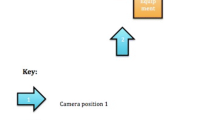Abstract
Background
The direction of visual gaze may be an important ergonomic factor that affects operative performance. We designed a study to determine whether a head-mounted display (HMD) worn by the surgeon would improve task performance and/or reduce muscle fatigue during a laparoscopic task when compared to the use of a traditional video monitor display (VMD).
Methods
Surgical residents (n = 30) were enrolled in the study. A junior group, consisting of 15 postgraduate year (PGY) = 1 subjects with no previous laparoscopic experience, and a senior group, consisting of 15 PGY 4 and PGY 5 subjects with experience, completed a laparoscopic task that was repeated four times using the Computer Enhanced Laparoscopic Training System (CELTS). Groups alternated between using the HMD with the task placed in a downward frontal position and the VMD with the task at a 30° lateral angle. The CELTS module assessed task completion time, depth perception, path length of instruments, response orientation, motion smoothness; the system then generated an overall score. Electromyography (EMG) was used to record sternocleidomastoid muscle activity. Display preference was surveyed.
Results
The senior residents performed better than the junior residents overall on all parameters (p < 0.05) except for motion smoothness, where there was no difference. In both groups, the HMD significantly improved motion smoothness when compared to the VMD (p < 0.05). All other parameters were equal. There was less muscle fatigue when using the VMD (p < 0.05). We found that 66% of the junior residents but only 20% of the senior residents preferred the HMD.
Conclusions
The CELTS module demonstrated evidence of construct validity by differentiating the performances of junior and senior residents. By aligning the surgeon’s visual gaze with the instruments, HMD improved smoothness of motion. Experienced residents preferred the traditional monitor display. Although the VMD produced less muscle fatigue, inexperienced residents preferred the HMD, possibly because of improved smoothness of motion.




Similar content being viewed by others
References
R Arndt (1983) ArticleTitleWorking posture and musculoskeletal problems of video display terminal operators-review and reappraisal Am Indus Hygiene Assoc 44 437–446 Occurrence Handle1:STN:280:BiyB2sbotlc%3D
R Berguer (1997) ArticleTitleSurgical technology and the ergonomics of laparoscopic instruments Surg Endosc 12 458–462 Occurrence Handle10.1007/s004649900705
R Berguer GT Rab H Abu-Ghaida A Alarcon J Chung (1997) ArticleTitleA comparison of surgeons’ posture during lagaroscopic and open surgical procedures Surg Endosc 11 139–142 Occurrence Handle10.1007/s004649900316 Occurrence Handle1:STN:280:ByiB383ltVY%3D Occurrence Handle9069145
R Berguer DL Forkey WD Smith (1999) ArticleTitleErgonomic problems associated with laparoscopic surgery Surg Endosc 13 466–468 Occurrence Handle10.1007/s004649901014 Occurrence Handle1:STN:280:DyaK1M3ksVOnug%3D%3D Occurrence Handle10227943
R Berguer CY Chen WD Smith (1999) ArticleTitleA virtual instrument ergonomics workstation, to measure surgeons’ physical stress Stud Health Technol Inform 62 49–54 Occurrence Handle1:STN:280:DyaK1Mzgsl2rsQ%3D%3D Occurrence Handle10538398
R Berguer DL Forkey WD Smith (1999) ArticleTitleThe effect of laparoscopic instrument working angle on surgeons’ upper extremity workload Surg Enodosc 15 1027–1029
R Berguer WD Smith YH Chung (2001) ArticleTitlePerforming laparoscopic surgery is significantly more stressful for the surgeon than open surgery Surg Endosc 15 1204–1207 Occurrence Handle10.1007/s004640080030 Occurrence Handle1:STN:280:DC%2BD3MnotV2gsA%3D%3D Occurrence Handle11727101
WK Cheah JE Lenzi J So F Dong CK Kum P Goh (2001) ArticleTitleEvaluation of a head-mounted display (HMD) in the performance of a simulated laparoscopic task Surg Endosc 15 990–991 Occurrence Handle10.1007/s004640090026 Occurrence Handle1:STN:280:DC%2BD3MrlvVCrtw%3D%3D Occurrence Handle11443461
S Cotin N Stylopoulos S Dawson M Ottensmeyer P Neumann R Bardsley M Russel et al. (2003) ArticleTitleCELTS: a clinically-based Computer Enhanced Laparoscopic Training System Stud Health Technol Inform 94 336–342 Occurrence Handle15455919
GB Hanna SM Shimi A Cuschieri (1998) ArticleTitleTask performance in endoscopic surgery is influenced by location of the image display Ann Surg 227 481–484 Occurrence Handle10.1097/00000658-199804000-00005 Occurrence Handle1:STN:280:DyaK1c3it12qtQ%3D%3D Occurrence Handle9563533
FMQ Leoni F Molle G Scavino A Dicknian (1994) ArticleTitleIdentification of the preferential gaze position through evaluation of visual fatigue in a selected group of VDU operators Doc Ophthalmol 87 189–197 Occurrence Handle10.1007/BF01204797 Occurrence Handle7835189
M Menozzi AV Buol C Miege (1994) ArticleTitleDirection of gaze and comfort: discovering the relation for the ergonomic optimization of visual tasks Ophthal Physiology 14 393–399 Occurrence Handle10.1016/0275-5408(94)90166-X Occurrence Handle1:STN:280:ByqC2cfisVA%3D
NT Nguyen HS Ho WD Smith C Philipps C Lewis RM DeVera R Berguer (2001) ArticleTitleAn ergonomic evaluation of surgeons’ axial skeletal and upper extremity movements during laparoscopic and open surgery Am J Surg 182 720–724 Occurrence Handle10.1016/S0002-9610(01)00801-7 Occurrence Handle1:STN:280:DC%2BD387ktVOitg%3D%3D Occurrence Handle11839346
WD Smith YH Chung R Berguer (2000) ArticleTitleA virtual instrument ergonomics workstation for measuring the mental workload of performing video-endoscopic surgery Stud Health Technol Inform 70 309–315 Occurrence Handle1:STN:280:DC%2BD3M%2FgsFWhuw%3D%3D Occurrence Handle10977562
N Stylopoulos S Cotin SK Maithel M Ottensmeyer P Jackson R Bardsley P Neumann et al. (2004) ArticleTitleComputer Enhanced Lapagoscopic Training System (CELTS): bridging the gap Surg Endosc 18 782–789 Occurrence Handle10.1007/s00464-003-8932-0 Occurrence Handle1:STN:280:DC%2BD2czhsFWjsA%3D%3D Occurrence Handle15216861
JJM VanKoesveld GWM Tetteroo EJR deGraff (2003) ArticleTitleUse of head-mounted display in transanal endoscopic microsurgery Surg Endosc 17 943–946 Occurrence Handle10.1007/s00464-002-9067-4 Occurrence Handle1:STN:280:DC%2BD3s3nvFarsg%3D%3D Occurrence Handle12632129
MA Veelen Particlevan G Kazemier J Koopman RH Goossens DW Meijer (2002) ArticleTitleAssessment of the economically optimal operating surface height for laparoscopic surgery J Laparoendosc Adv Surg Tech 12 47–52 Occurrence Handle10.1089/109264202753486920
Acknowledgments
This work was supported in part by an educational grant from Stryker Endoscopy. We thank Dr. Sanjeev Nandedkar for help and guidance with EMG acquisition and analysis. We are also grateful to Amie Goldberg for help with statistical data analysis
Author information
Authors and Affiliations
Corresponding author
Rights and permissions
About this article
Cite this article
Maithel, S.K., Villegas, L., Stylopoulos, N. et al. Simulated laparoscopy using a head-mounted display vs traditional video monitor: an assessment of performance and muscle fatigue. Surg Endosc 19, 406–411 (2005). https://doi.org/10.1007/s00464-004-8177-6
Received:
Accepted:
Published:
Issue Date:
DOI: https://doi.org/10.1007/s00464-004-8177-6




